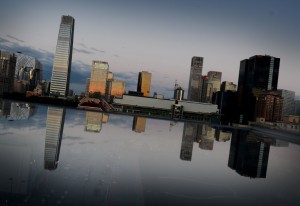
A view of the Central Business District is reflected on a window in Beijing on September 3, 2012. China’s industrial output growth weakened in August to its slowest pace in more than three years, official figures showed Sunday, confirming a deepening slowdown in the world’s second-biggest economy. AFP PHOTO/MARK RALSTON
BEIJING—China’s industrial output growth weakened in August to its slowest pace in more than three years, official figures showed Sunday, confirming a deepening slowdown in the world’s second-biggest economy.
Production increased just 8.9 percent year on year last month, the National Bureau of Statistics announced – the lowest result since a similar rise of 8.9 percent in the depths of the global economic crisis in May 2009.
China’s economy has seen a marked easing over the past year, expanding 7.6 percent in the second quarter of 2012, the worst performance in three years and the sixth straight quarter of easing.
The latest gloomy readings come as export-reliant nations feel the pinch from collapsing demand caused by the long-running debt crisis gripping Europe and the stuttering recovery in the United States.
China’s August output figure “says clearly that growth was weakened further,” Lu Ting, China economist at Bank of America Merrill Lynch, said in a report.
Also Sunday, the statistics bureau announced that China’s inflation rate accelerated slightly in August amid higher costs for food, potentially limiting the government’s ability to enact fresh monetary stimulus measures.
Consumer prices rose 2.0 percent year on year as food prices increased 3.4 percent. Inflation stood at 1.8 percent in July.
Chinese authorities have taken steps this year to stimulate growth by cutting interest rates twice in quick succession and slashing the amount of funds banks must keep in reserve as ways to increase lending.
Analysts have been expecting further monetary loosening to fire growth, though the slight rise in inflation makes another decrease in interest rates less of an option because of the inflationary risks they pose.
“The likelihood of a cut is now clearly smaller than last month,” IHS Global Insight economists Ren Xianfang and Alistair Thornton said in a report, emphasizing that higher consumer prices make it harder to “absorb the inflationary pressure” of monetary stimulus.
Their report said the government was more likely to favor other tools such as fiscal stimulus, to help boost the economy.
State media reported Friday that China had approved a huge infrastructure package worth more than 1.0 trillion yuan ($158 billion), involving 55 infrastructure projects ranging from subway lines to highways.
China carried out a huge 4.0 trillion yuan fiscal stimulus package in the wake of the global financial crisis in 2008.
The statistics bureau also said Sunday that urban fixed asset investments – a key measure of government spending on infrastructure – rose 20.2 percent in the first eight months of 2012 compared with the same period the year before. The figure for the first seven months until July was 20.4 percent.
Retail sales, China’s main gauge of consumer spending, were 13.2 percent higher in August year on year, the bureau said, marginally better than the 13.1 percent increase recorded in July.

